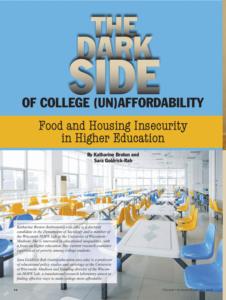Some students from low-income families are unable to pay their college costs without experiencing material hardship. What they do to make ends meet (e.g., go hungry and homeless) inhibits learning and discourages persistence. Strategic college leaders investigate the needs of their students and draw on the strengths of their institutions and those of their communities to meet those challenges: for example, by changing school policies and financial due dates, creating short-term interest-free loan programs at the beginning of the school year, hiring counselors with social-work backgrounds, working with local food banks and housing authorities, and offering free tax-preparation services. Institutions can also collaborate with non-profit organizations such as the College and University Food Bank Alliance, Single Stop, and the Center for Working Families to help students access existing social-safety-net resources. Changes to federal and state policies that increase access to food stamps or extend the school lunch program to college students could better support students with financial need.

